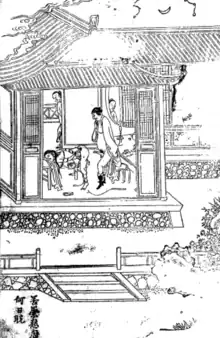Bian er chai
Bian er chai (Chinese: 弁而釵; pinyin: Biàn ér chāi)[lower-alpha 1] is an anthology of homoerotic short stories by an unknown author published in the late Ming dynasty.
 An illustration of a rape scene in the fourth story "Qingqi ji" (情奇纪) from an edition of Bian er chai published in the Ming dynasty, c. 1639.[1] | |
| Author | "The Moon-Heart Master of the Drunken West Lake" (醉西湖心月主人) |
|---|---|
| Original title | 弁而釵 |
| Country | China (Ming dynasty) |
| Language | Chinese |
Publication date | c. 1628–1644 |
| Media type | |
Contents
Bian er chai comprises four short stories that revolve around homosexual relationships; each story is five chapters long.[3] "Qingzhen ji" (情贞纪) or "A Story of Chaste Love"[4] follows a member of the Hanlin Academy who poses as a student to seduce a boy;[3] in "Qingxia ji" (情侠纪) or "A Story of Chivalric Love",[4] a decorated soldier is seduced by a man;[5] "Qinglie ji" (情烈纪) or "A Story of Sacrificing Love"[4] explores the love life of a young male opera singer;[6] and in "Qingqi ji" (情奇纪) or "A Story of Extraordinary Love",[4] a young catamite is rescued from the brothel by an older lover, only to encounter further tribulations.[6]
Publication history
Bian er chai was written in classical Chinese[7] by an anonymous writer using the pseudonym "The Moon-Heart Master of the Drunken West Lake" (醉西湖心月主人),[8][lower-alpha 2] who is also believed to have written another homoerotic short story collection titled Yichun xiangzhi (宜春香質) or Fragrance of the Pleasant Spring,[8] as well as a preface for Cu hulu (醋葫蘆), a novella about a shrewish wife.[3] Surviving editions of Bian er chai also contain interlinear commentary by "The Daoist Master Haha What Can You Do About Fate" (奈何天呵呵道人).[10] The novel was first published during the reign of the Chongzhen Emperor (1628–1644)[11] by the obscure "Plowing the Mountain with a Brush Studio" (筆耕山房),[10] and was later banned by the Qing government.[12] Two extant editions of Bian er chai are known to exist: one is housed at the Beijing Municipal Library and the Tenri Central Library in Japan, while the other is held in the National Palace Museum in Taipei.[10]
Notes
References
Citations
- Stevenson & Wu 2012, p. 173.
- Stevenson & Wu 2012, p. 170.
- McMahon 1987, p. 229.
- Huang 2020, p. 176.
- McMahon 1987, p. 231.
- McMahon 1987, p. 233.
- Volpp 2002, p. 951.
- Huang 2020, pp. 176–177.
- Stevenson & Wu 2012, p. 183.
- Volpp 2020, p. 252.
- Huang 2020, p. 177.
- Duberman, Vicinus & Chauncey 1990, p. 84.
Bibliography
- Duberman, Martin B.; Vicinus, Martha; Chauncey, George (1990). Hidden from History: Reclaiming the Gay and Lesbian Past (4 ed.). Meridian. ISBN 9780452010673.
- Huang, Martin W. (2020). "Qing and Homoerotic Desire in Bian er chai and Lin Lan Xiang". Desire and Fictional Narrative in Late Imperial China. Brill. pp. 176–205. doi:10.1163/9781684173570_009. ISBN 9781684173570.
- McMahon, Keith (1987). "Eroticism in Late Ming, Early Qing Fiction: The Beauteous Realm and the Sexual Battlefield". T'oung Pao. Brill. 73 (4): 217–264. doi:10.1163/156853287x00032. JSTOR 4528390. PMID 11618220.
- Stevenson, Mark; Wu, Cuncun (2012). Homoeroticism in Imperial China (1 ed.). Routledge. doi:10.4324/9780203077443. ISBN 9780203077443.
- Volpp, Sophie (August 2002). "The Literary Circulation of Actors in Seventeenth-Century China". The Journal of Asian Studies. 61 (3): 949–984. doi:10.2307/3096352. JSTOR 3096352.
- Volpp, Sophie (2020). Worldly Stage: Theatricality in Seventeenth-Century China. Brill. doi:10.1163/9781684174355. ISBN 9781684174355.